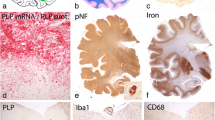Abstract
Multiple sclerosis (MS) is an inflammatory disease of the CNS white matter characterized pathologically by the accumulation of perivascular and parenchymal T lymphocytes (T cells), and macrophage infiltration associated with myelin destruction. MS lesions are also characterized by the death of oligodendrocytes (the myelin-producing cells) and proliferation and hypertrophy of astrocytes with scar tissue (gliosis) replacing normal myelin. These changes result in the loss of axonal conduction for neurons of the CNS and in clinical disability. MS is thought to be an autoimmune disease, in particular because of its analogy with the disease model of experimental allergic encephalomyelitis (EAE). Despite extensive research and the availability of various EAE models in laboratory rodents the etiology of human MS has not been identified, and to date no effective treatment exists. Phylogenetic differences may limit the usefulness of existing EAE models, and indeed no single form of rodent EAE recapitulates all the clinical and pathological features of MS. Here we describe a novel form of EAE created in a nonhuman primate, the common marmoset Callithrix jacchus. Active immunization of these monkeys with whole myelin produces a primary demyelinating disease with a chronic relapsing-remitting course, characterized pathologically by moderate inflammation with prominent and early demyelination and gliosis reminiscent of human MS. Adoptive and passive transfer experiments have permitted definition of the mechanisms responsible for the MS-like pathology. Production of the fully demyelinated lesion requires synergism between encephalitogenic (e.g., disease-inducing) T cells and pathogenic antibody. The antigens of myelin that promote encephalitogenic T cell and antibody responses in this system have been identified. Because of the similarity between the two conditions and the high degree of conservation in immune and nervous system genes between nonhuman primates and humans, future studies of marmoset EAE will likely accelerate the development of therapies for human MS.
Similar content being viewed by others
Author information
Authors and Affiliations
Additional information
Received: 6 June 1996 / Accepted: 17 December 1996
Rights and permissions
About this article
Cite this article
Genain, C., Hauser, S. Creation of a model for multiple sclerosis in Callithrix jacchus marmosets. J Mol Med 75, 187–197 (1997). https://doi.org/10.1007/s001090050103
Issue Date:
DOI: https://doi.org/10.1007/s001090050103




